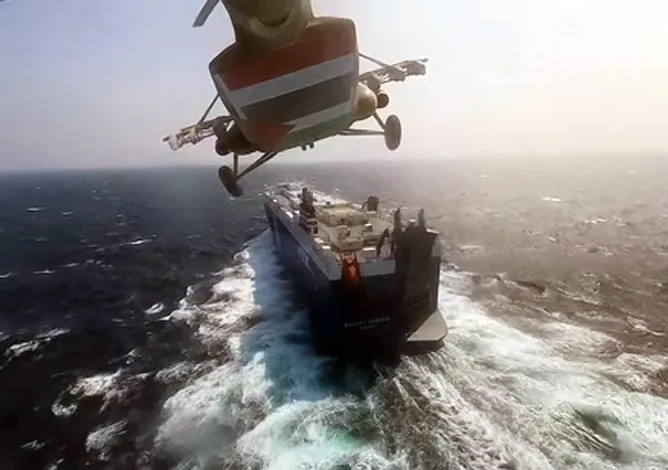-
CENTRES
Progammes & Centres
Location
Regional security in West Asia stands at a precarious intersection.

Military actions by the Yemen-based Houthi militia, officially known as Ansrallah, targeting commercial ships in the Red Sea have opened a new theatre within the ongoing Israel-Hamas war in Gaza. An attack on an oil tanker in late December sailing between Saudi Arabia and India, MV Chem Pluto, by a projectile, purportedly fired from the region, hitting the vessel barely 200 nautical miles from Indian shores, raised red flags over the prospects of the West Asian conflict spilling far into the Arabian Sea.
External affairs minister S Jaishankar’s visit to Iran seemed to be centred around this developing security spiral. While it is unclear whether this visit was planned only recently or not, the probability of the trip taking shape due to the rising attacks on commercial ships in the Red Sea by the Houthis, a group known to enjoy the patronage of Iran, seems favourable. But what are the Houthis planning, and what security issues does this raise for New Delhi?
The Houthis rallying behind Palestinians and attacking the United States (US) and Israel over Gaza is in large part to shore up domestic and regional support for themselves.
The Houthis have been a central player in the Yemeni war for nearly a decade. In 2015, as the war in Yemen escalated, India successfully mobilised its diplomacy with Saudi Arabia and Iran to install ceasefires in the country’s capital Sana’a to evacuate its citizens by air. However, back then the Houthis were small in capacity with finite means, both financially and materially. Today, as a quasi-official part of Iran’s “resistance” across the region, the group boasts expansive capacities that include anti-ship cruise missiles. Other weapons in the arsenal include anti-ship ballistic missiles (range over 450 km), armed speed boats, torpedoes, drones, radars, and equally importantly, an increasingly expansive online propaganda ecosystem on major social media platforms. The Houthis rallying behind Palestinians and attacking the United States (US) and Israel over Gaza is in large part to shore up domestic and regional support for themselves.
“We have even seen some attacks in the vicinity of India. Obviously, it also has a direct bearing on India’s energy and economic interests. This fraught situation is not to the benefit of any party and this must be clearly recognised,” Jaishankar said in a statement in Tehran. Contrarily, the statement from the Iranian side said that they underscored the importance of security in international waters and that the White House’s support for war crimes “by the Zionists paves the way of spillage of instability across the region”. These reveal starkly different views and interpretations.
The Iranian web of proxies installed across the region, which includes the Houthis, has been targeting western, particularly American installations in Iraq and Syria, for months. These proxies also have elements from South Asia, in the way of the Fatemiyoun Brigade manned by Afghan Shias and the Zainabiyoun Brigade manned by Pakistani Shias. In both cases, the fighters come from the two countries directly but predominantly from ethnic populations already in Iran. Pressure has been growing on the Biden administration to deliver a stern response. However, with elections looming, the White House may not want to start another conflict.
The Iranian web of proxies installed across the region, which includes the Houthis, has been targeting western, particularly American installations in Iraq and Syria, for months.
India may have little sway with Iran at this moment. Since the government decided to stop buying oil from the country owing to sanctions and pressure from the then-US administration in 2018, India–Iran ties have been brought down to the bare minimum. Moreover, the rapidly increasing investment and trade relations with the Arab powers, notably UAE and Saudi Arabia, alienate Tehran.
Regional security in West Asia stands at a precarious intersection. While Tehran is utilising the war in Gaza to further its agendas, Riyadh, technically at war with the Houthis since 2015, normalised relations with Iran last year in a deal brokered by China. This decision in part was taken by the Saudis due to an increasingly unreliable American security umbrella. This has perhaps been the most tectonic change in strategic positioning since February 1945 when then US President Franklin D Roosevelt and Saudi King Abdul Aziz Ibn Saud met on board the warship USS Quincy in the Suez Canal to seal an “oil for security” arrangement.
A debilitating security situation around these critical sea routes has always been a recurring strategic conundrum for India. The recent successes of non-State militant actors – the Taliban in Afghanistan to the Houthis in Yemen – bring a perilous trend of well-armed militia-run extremist States within its sphere of strategic influence, interest, and security. New Delhi’s security challenges have expanded.
This commentary originally appaered in Hindustan Times.
The views expressed above belong to the author(s). ORF research and analyses now available on Telegram! Click here to access our curated content — blogs, longforms and interviews.

Kabir Taneja is a Deputy Director and Fellow, Middle East, with the Strategic Studies programme. His research focuses on India’s relations with the Middle East ...
Read More +